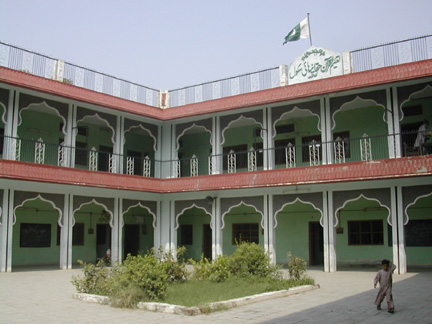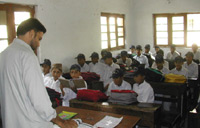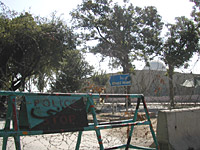Interview
Education mullah style
by Tony Cross
Article published on the 2008-05-11 Latest update 2008-05-14 15:44 TU
North West Frontier Province, Pakistan, September 2007
Hundreds of white-robed faithful listen to a preacher in the courtyard at the Dar-ul Uloom-Haqqania madrassa.
The huge religious school is about an hour’s drive from Peshawar, the North West Frontier Province capital. Founded in 1947, the madrassa currently has about 3,000 students studying a variety of subjects ranging from Islam to computer science.
A class of small boys in neat uniforms learns English, mullah style. Following the lead of one of their classmates, they chant lesson one: "The life of Mohamed, peace be upon him".
Many poor Pakistanis can’t afford to send their children to state-run schools, which, in any case, are starved of resources. So the thousands of madrassas fill the gap, providing free board and education.
Maulana Samiul Haq, who runs Dar-ul Uloom-Haqqania, was a friend and admirer of Taliban leader Mullah Omar, at one time advising him on international relations and sharia law.
Ties with the Taliban
According to Ahmed Rashid's book, Taliban, ul-Haq recruited thousands of fighters for the Taliban. When they suffered a defeat in Mazar-e-Sharif in 1997, he responded to a call for help by shutting down the madrassa and sending the entire student body off to fight.
Rashid says that in 1999 at least eight Taliban ministers were graduates of Dar-ul Uloom-Haqqania, while dozens more served as provincial governors, military commanders, judges and other officials.
Samiul Haq also leads one of several breakaway factions of the Jamaat-Ulema-Islam, the country’s second biggest Islamist party. Syeed Yusuf Shah, who teaches at the madrassa, is the faction’s North-West Frontier Province general-secretary.
He thinks the MMA, the coalition of Islamic parties, has sold out. "They are not doing as they promised, so we separated from them," he says. "They have just shown green gardens to the people that we will make Islamic region, and we will do this and that for Islam but they did not do that."
He accuses the MMA in his province of betraying the commitments in its manifesto.
"For example, one of them was that we will not help America, but we helped," he says. "So we showed to our nation that we would do this-this-this but we didn’t do even zero per cent for them. That’s why MMA is unsuccessful.”
Supporting the fight in Afghanistan
Syeed Yusuf is a calm, quiet-spoken man with the self-assurance of a respected religious leader. Like many devout moslems, he seems at peace with himself, if not with the rest of the world. He lets us know that inquisitive foreigners are not always welcome here, and that, had RFI's corrrespondent Beroz Khan not acted as intermediary, he probably wouldn't have agreed to this interview.
The maulana praises the deposed Taliban government, for "bringing peace" to Afghanistan, although he talks down the madrassa's role in supporting it.
He makes no bones about supporting those Taliban fighting the current Afghan government, claiming that President Hamid Karzai's writ extends no further than the presidential palace.
"I don't know if they will win or not, but they are struggling hard," he says. "They are opposing America because America is trying to occupy the whole world. America went to Iraq. America went to Palestine. America came to Afghanistan. It is just trying to occupy the whole world, and Taliban are against it."
Although he doesn’t disguise his contempt for President Pervez Musharraf, he avoids explicitly endorsing violence, such as the 2003 assassination attempts to get rid of him.
Islamist violence
Some Islamists don't exercise such patience. In the space of two weeks in September 2007, Pakistani papers carried the following reports:
- In the Swat district, an unsuccessful attempt to destroy ancient Buddhist monuments, which recalls the Afghan Talibans’ destruction of Buddha statues;
- Also in Swat, a meeting of barbers votes to fine colleagues who shave beards, after receiving death-threats from militants;
- A woman whose husband threw acid in her face is told not to seek help from an NGO because NGOs are supposed to be involved in “un-Islamic activity”;
- gunmen abduct and behead two alleged prostitutes in Bannu near the Afghan border.
Earlier in 2007, mullahs and religious students based at Islamabad’s Lal Masjid, the Red Mosque, clashed with the government over threats to demolish it. They set up their own sharia court and launched punitive raids in the surrounding area against alleged sinners, including Chinese masseuses whom they accused of being prostitutes.
After a long stand-off, security forces took the mosque by storm. The Islamists claim that up to 400 people died in the operation, although other estimates put the figure at about 100.
Although the Lal Masjid campaigners kidnapped police officers, shot a paramilitary ranger dead, set fire to the Environment Ministry and seriously annoyed China, many Pakistanis were angered by the army's behaviour.
"We oppose that operation," says Syeed Yusuf. "Musharraf killed a lot of children there. No-one should kill his countrymen like that."
Further violence
Later in the day the vice-president of the committee that oversees madrassas, Maulana Hassan Jan, is shot dead by two gunmen on a motorbike. Jan had received several death threats after declaring that suicide-bombers were anti-Islamic. Although that was as far as his condemnation of violence went, it was enough to earn a reputation as a moderate and the enemies to go with it.
Elsewhere in the province this week, a suicide-bomber walked into a high-security army camp and set off his device near the mess, killing over a dozen elite commandos who were involved in the Lal Masjid operation.Listen
Pakistan: religion and politics feature
2008-05-12 by Tony Cross








